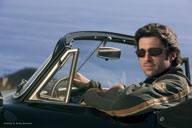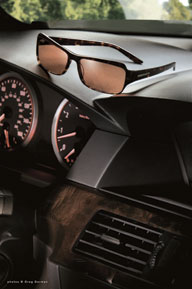With recent publicity on the dangers of blue light and the risk of macular degeneration (News, June 30), Bushnell Performance Optics, the company behind the Serengeti line of sunglasses, is planning a timely push on the medical benefits of its lenses. Andrew Grose, managing director of Bushnell Performance Optics UK, explains that from January next year there will be a strong marketing initiative on the eye protective qualities of the lenses and adds that this is partly as a result of receiving increasing numbers of enquiries from patients who have been recommended Serengeti sunglasses by eye hospitals. ‘It brings it home to us when we receive calls from patients who have just had retinal surgery and are recommended Serengeti for eye protection,’ he says.
Andrew Grose, managing director of Bushnell Performance Optics UK, explains that from January next year there will be a strong marketing initiative on the eye protective qualities of the lenses and adds that this is partly as a result of receiving increasing numbers of enquiries from patients who have been recommended Serengeti sunglasses by eye hospitals. ‘It brings it home to us when we receive calls from patients who have just had retinal surgery and are recommended Serengeti for eye protection,’ he says.
A recent Serengeti statement estimates that over one million of the 60-plus population group in France suffer from age-related maculopathy and the resulting diminishing vision. And in its latest promotional material and press releases the company points out that after cataract surgery, refractive surgery and in some other pathological and physiological conditions, polarising Serengeti glasses provide a solution for photophobia. There’s one thing that makes the lenses particularly suited for this type of wearer and that is the fact that they adapt to the light conditions.
Banishing blue light
The photochromic glass was originally developed by Corning for top-of-the-range car windsceens, to improve vision in changing light conditions and to give improved identification of the three main colours of red, amber and green for driving indicators and traffic lights. The glass was very expensive and the Drivers lens was developed out of it. These lenses block out 95 per cent of blue light, thanks to the Spectral Control System – the blue light that is allowed through being essential for true colour perception. Drivers lenses are photochromic, for the reduction of optical fatigue, as well as polarising, with the aim of removing dazzle. They are a brown-orange colour, although there is also a darker green option and all have an anti-reflection coating on the back of the lens. ‘They offer massive protection as well as lifting your vision in other conditions such as fog and rain. A lot of sunglasses block a certain amount of blue light – there are a lot of good lenses out there, but we are saying we are as good as all these plus we have the combination of polarised photochromic and the strong blue light filter. We have to go out on the health message as our point of difference,’ adds Grose.
‘They offer massive protection as well as lifting your vision in other conditions such as fog and rain. A lot of sunglasses block a certain amount of blue light – there are a lot of good lenses out there, but we are saying we are as good as all these plus we have the combination of polarised photochromic and the strong blue light filter. We have to go out on the health message as our point of difference,’ adds Grose.
He explains that it can be difficult to get the protective message across in optical practices when so many patients are seeking the glamour and fashion-branded sunglass names. ‘Everyone who walks into an opticians could benefit from Serengeti lenses and opticians are best placed to offer advice to consumers, from eliminating glare to eye fatigue. Serengeti is renowned for sophisticated styling, not what a footballer’s wife is wearing on the front of Heat magazine.’
The two latest models, just released, are certainly appealing to those who want fashion along with performance, the women’s design Zina (pictured on dash) in particular. This is a laminated acetate frame in tortoiseshell or charcoal in a 6-base design. Also new is the men’s model Napoli, an aviator style in a slightly wrapped base-8 frame, a modern interpretation of a vintage look in satin gun and expresso finishes.
The lenses are also available in prescription form, made in exactly the same way as the plano lenses, through Barberini of Italy.
‘The prescription side of business has really grown for us, through the more discerning customer who really values excellent vision and protection. People want the best and are prepared to pay for it, while the optician is happy to sell the exact replica from Barberini.’
Grose adds that, while the optician is aware of the protective qualities of such a lens, they will not necessarily be selling the sunglasses, so the education process must involve the sales people.
‘We are driving home to opticians and staff that they can make money as well as giving professional advice and education.’
The company also has a flash demonstrator to show the photochromic effect of the lenses. ‘They’re particularly suited to patients with light sensitive eyes, who want to keep the sunglasses on, giving constant protection,’ he says.
A recent addition to the Serengeti line is the PolarMax (photo above and inset) range. The sunglasses combine all the properties of Serengeti polarised lenses with ultra-light polycarbonate. PolarMax is molecularly engineered into the lens so it is not a coating. The process is exclusive to Serengeti and it never wears out or wears off, says Grose.
The message about the need for the older wearer to care for their eyes certainly seems to have reached higher places, with a recent photo of the Pope showing him to be sporting a pair of Serengeti sunglasses in the Popemobile. Although not driving himself, he’s clearly not taking risks with his vision.
Register now to continue reading
Thank you for visiting Optician Online. Register now to access up to 10 news and opinion articles a month.
Register
Already have an account? Sign in here
